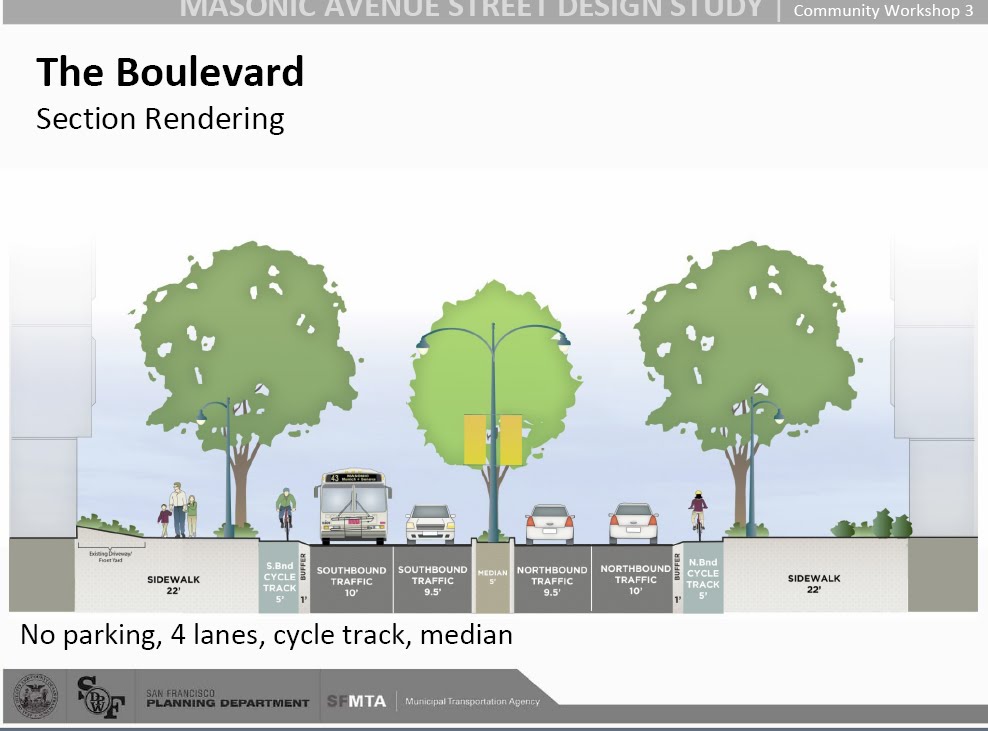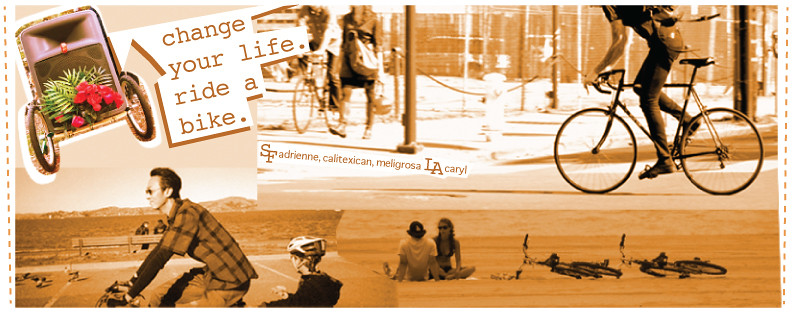In reaction to the latest pedestrian fatality residents of neighborhoods surrounding major traffic artery Masonic Avenue are asking city officials to take action in slowing the traffic on one of San Francisco's busiest streets.

photo by stephen dorian miner
Living close to Masonic first hand I am all too aware of the danger and intensity that cars driving double the speed limit bring not only to cyclists, but also to pedestrians. Blind intersections dot the area due to drivers not being able to see past the many small hills that run through Masonic. This poses a huge threat to cyclists not only riding on Masonic, but especially to cyclists and pedestrians trying to cross Masonic in areas where they are not protected by street lights.
A letter written by Elizabeth Stampe, the Executive Director of Walk San Francisco, to the San Francisco Metro Transit Authority explicitly outlines their support of the boulevard design to help improve the safety of Masonic.
With permission I have copied the letter in this post:
May 10, 2011
To the SFMTA:
Walk San Francisco is writing to strongly support the “boulevard” option for Masonic Avenue.
Today, Masonic Avenue is tragically unsafe. Just last Friday, 61-year-old James Hudson was killed by a speeding car while walking in a crosswalk. The circumstances were similar to those of Nils Yannick Linke, killed there last year on his bike. Last month, a woman was hit by a speeding car on Masonic at Grove and very seriously injured.
In our city, 100 people are seriously injured or killed every year. One of the most powerful things we can do to change this is to reduce traffic speeds on our arterial streets like Masonic. These wide fast streets are where the worst crashes occur, and where we have the most potential to save lives.
Some say that, because the two recent deaths on Masonic were caused by drunk drivers, that redesigning the street will not help. We strongly disagree. Design drives behavior, and the design of this stretch of Masonic Avenue encourages speeding, whatever the condition of the driver.
Last year there were four pedestrian injury collisions along Masonic: two were at Hayes and O’Farrell, and the other two were just outside the study area; at Oak and at Haight. Many other collisions occur along this stretch that do not involve pedestrians – Bike NOPA reported two serious collisions at Masonic and Hayes just in the last four days.
The boulevard option for redesigning Masonic will narrow the street, calm the traffic, and reduce speeding. This will make the area safer for pedestrians, and in fact, for all road users.
Walk San Francisco supports the boulevard option because it includes:
• A road diet, removing lanes to narrow the street and reduce speeding
• A tree-planted median; trees visually narrow the street
• Expanded sidewalks (bulb-outs) at corners and bus stops to shorten crossing distances and improve pedestrian visibility
• More visible crosswalks to improve pedestrian visibility and encourage yielding
• Separate cycle tracks to provide a buffer between cars and pedestrians
Walk San Francisco encourages you to lose no time in moving forward to rebuild Masonic to safer speeds with the boulevard option.
Sincerely,
Elizabeth Stampe
Executive Director
Walk San Francisco
Reprinted with permission.
Send your message now for a Safer, Better Masonic:sustainable.streets@sfmta.com; write "Public Hearing" in the subject line.

diagram provided by SF Planning Department and SFMTA via SFBC
Most recently the effects of a road diet can be seen on Valencia Street. Wider sidewalks and generous bike lanes and wide sidewalks have made the street much more pedestrian friendly and in turn also more commercially friendly. I believe that similar effects would happen on Masonic Avenue as well, though not a commercial corridor like Valencia, Masonic goes through many commercial districts of San Francisco where high pedestrian traffic is common. Other cities such as Sunnyvale, Mountain View and Palo Alto have used road diets to great effect as well.
Facts: 2 Pedestrian fatalities in the last 10 months, along with 30,000 vehicles on Masonic daily. Cost of the entire project would total $20 million.
You can also help by attending the public hearing Friday May 13th for the proposed boulevard redesign at 10 A.M. room 466 at City Hall.





I love the road diet and wish this would happen to one of the major road in Flag, although it's not something many people can seem to wrap their heads around. I think most people think making the road bigger is the solution.
ReplyDelete